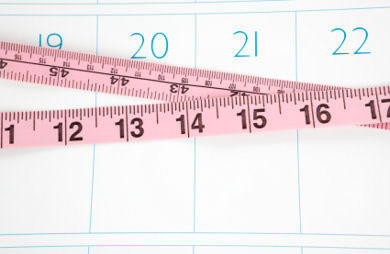|
Like any public place, gyms have different volumes of traffic at different types of year. During one of these peak periods, you might be dismayed to show up and find that everybody and their mother—and their brother, sister and second cousin—had the same idea. The locker room resembles Grand Central Station, there's a wait list for the treadmills and there's no way you're doing crunches for an audience of dozens. But that doesn't mean you have to hightail it to the car. With a few smart strategies, you can confidently navigate a jam-packed gym. Tip #1: Go during non-peak hours.Just as grocery shopping takes more of your time and energy at noon on Saturday than it would on Tuesday evening, hitting the gym during peak times can affect your motivation. What would normally be a simple 30-minute workout can easily take twice as long when you're waiting for machines. To remedy this, yoga instructor Ysmay Walsh recommends planning your sessions during off-peak hours, which can be challenging for those who work a traditional 9-to-5 schedule. "The less busy times are usually from 10 to 12 in the morning, between 2 and 5 p.m., and between 8 to 11 in the evening," Walsh says. "Group exercise classes are often cheaper during these off-peak times as well." If you're not sure of the most crowded times at your gym, call and ask before planning your workouts. Tip #2: Arrive to fitness classes early.Showing up to a jam-packed cycling class or fighting for space in a crowded yoga studio can be daunting—especially if you're new to the exercise scene. Plan to arrive to any group fitness class at least 15 minutes early, which should give you plenty of time to secure a spot, meet the instructor and get some pointers if necessary. Tip #3: Grab a corner.As long as you have the basic necessities, you can accomplish a lot in a small space. Personal trainer Kim Schaper recommends setting up shop in a corner of the gym. "Gather your favorite gear—dumbbells, a mat, a band, maybe a kettlebell—and you're good to go," she says. "Have a circuit ready, stay in your little area and you can knock out a great workout while avoiding all the noise." If your gym has studio space, MomTrainer's Sarah Ann Kelly recommends asking if you can use it when classes aren't being held. "Cardio rooms will usually have everything you need, and lots of space to stretch, lunge or jump rope." Tip #4: Give the neglected machines some love.Newbies often make a beeline for the treadmills and ellipticals, so consider experimenting with machines that are rarely used. Tricia Brouk, owner of Brouk Moves, recommends trying the old-school stair climber: "This awesome piece of equipment is an excellent source of cardio and few people use it." Rowing machines and stationary bikes are also effective and more readily available. Another often overlooked option is the cable machine. "When everyone is fighting over dumbbells, plant yourself at the cable machine and get an entire workout while standing in one place," Brouk suggests. Some examples of effective cable machine exercises include bicep curls, lunges, chest flys, standing upright rows and standing hip abductors. Tip #5: Go boutique.If you want to stick to your resolutions while avoiding the January craziness, consider skipping the larger gyms in favor of a small personal training or group fitness studio. These boutique-style fitness centers may cost more than a traditional gym, but they offer the benefits of personalized instruction, specialized equipment and a supportive community. Plus, because many studios require participants to sign up in advance and have a limit on the number of students in each class, you won’t find yourself swimming in a super-crowded space. Desima Dawdy, an instructor and owner of Pilates Performance and Rehab, greets a lot of New Year's registrants who want a more peaceful environment to kick-start their new lifestyle. "The great thing about working out at a boutique training studio is that when clients receive individual quality instruction, their attendance is generally not seasonal," she says. "They are committing to a permanent, not seasonal, lifestyle change with like-minded people." Tip #6: Wear headphones.A jam-packed gym is likely to have plenty of distractions—but you came to get fit, not to catch up on strangers' gossip. Tyler Spraul, trainer with Exercise.com, recommends bringing headphones to help you stay focused on the task at hand. "Wireless Bluetooth headphones are nice to have, so you don't have to worry about getting any wires tangled up in machines or weights," he says. Don't forget to download a motivating playlist before heading out! Tip #7: Use your own body weight.Who says you need dumbbells, barbells or a fancy machine? When space and equipment are at a premium, don't underestimate the effectiveness of bodyweight exercises, most of which can be performed in the usually fairly empty stretching area or an unused fitness studio. "There are plenty of exercises you can do without a single piece of equipment," says trainer Kristy Stabler. "These include pushups, sit-ups, planks, squats, lunges and plyometric exercises like jumping jacks, squat jumps, lunge jumps and more." Tip #8: Have a workout plan—and a backup.You wouldn't go grocery shopping without a list—so why show up to the gym without a workout plan? "Before heading out, take the time to make a list of the exercises you'd like to do, and then have at least one backup for each in case the weights or machines are in use," recommends trainer Cheryl Russo. "If you don't know a lot of exercises, do an online search." As an example, if you want to do bicep curls, your first preference might be to use dumbbells, but you could also use a curl bar, straight bar or the cable machine. For triceps, you can do dumbbell extensions, dips, cable push downs or curl bar skull crushers. "If a piece of equipment is taken, move on to something else," Russo suggests. "Also, be open to changing the order of exercises. If you plan on doing biceps first but everything is in use and you see that a bench is open for dips, switch to doing triceps first." Tip #9: Hire a trainer.If you're a beginner, consider working with a personal trainer to get acquainted with the layout, machines, equipment and protocol. "You'll learn how to use your gym effectively, get a much better workout and learn the 'rules' of training," says Kelly. "With an experienced trainer by your side, you’ll be better equipped to navigate the lines and crowds like a pro." Tip #10: Ask to "work in."You came to the gym to work out, so what's this talk about working in? This is gym lingo for using a piece of equipment in between someone else's sets. For example, if bicep curls are next on your circuit and you notice a woman who is just finishing up with that machine, you can politely ask to work in your own set while she's resting. "Even if you're a female, don't be afraid to stick your head out and ask to work in with someone," says Schaper. "You are just as entitled to use that piece of equipment as they are." That said, there are some scenarios when working in doesn't make sense, as Spraul points out. "If someone is squatting 300-plus pounds and you'd need to remove a ton of plates to get your work done, maybe it's best to find another exercise variation, instead." Not crazy about the idea of working in with strangers? Hit the gym with a workout partner so you can alternate between exercises and share equipment. There’s no need to let a gym rush bring your goals to a screeching halt. By employing some of these strategies, you can successfully navigate the crowds and keep your workouts going all year long. |
More From SparkPeople
|




.png)







.jpg)









.jpg)